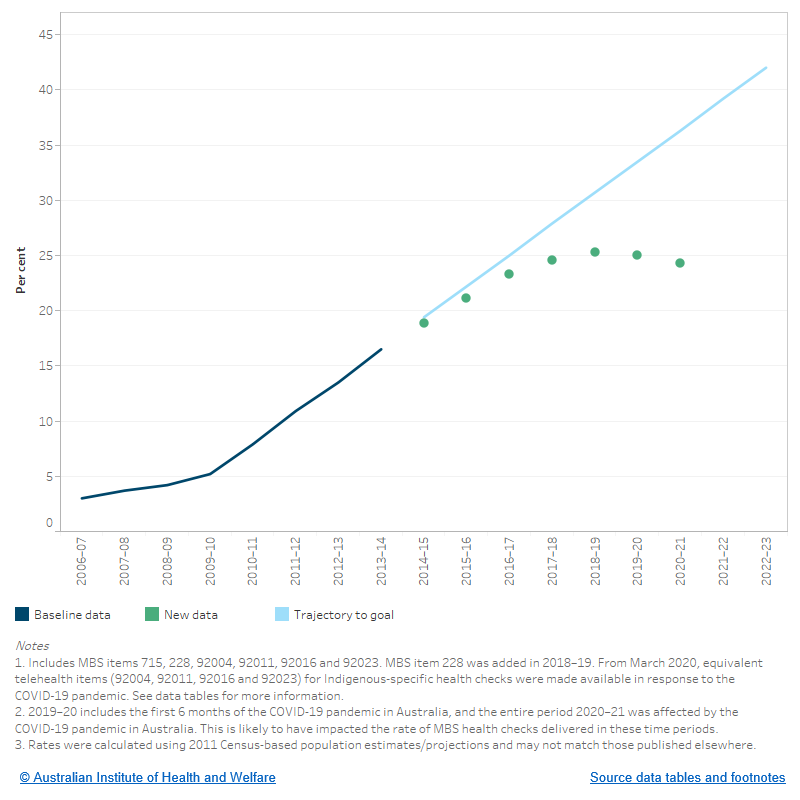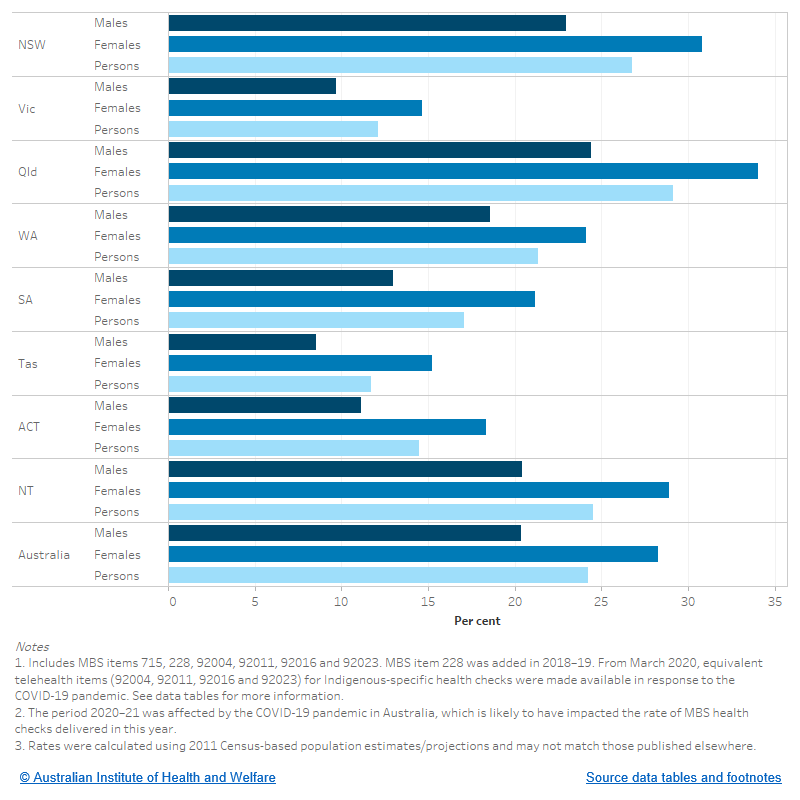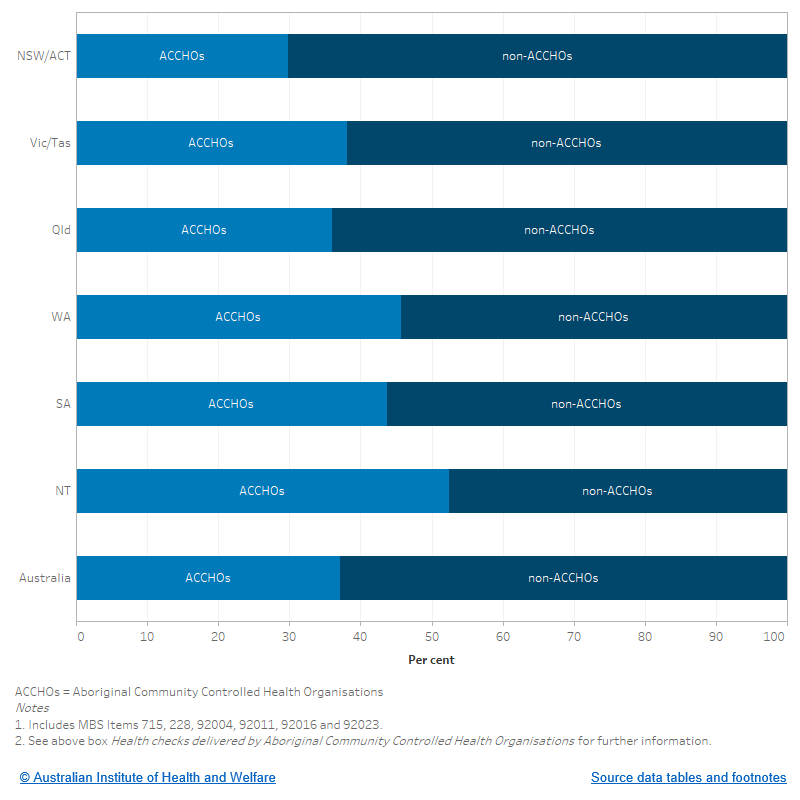Goal 13: Indigenous-specific health checks – people aged 15–24
This indicator reports on the rate of Indigenous-specific Medicare Benefits Schedule (MBS) health checks among Aboriginal and Torres Strait Islander people aged 15–24. The goal for this indicator is 42% by 2023.
Why is it important?
All Aboriginal and Torres Strait Islander people are eligible for an annual Indigenous-specific health check, subsidised through Medicare. These checks can be received for free at Aboriginal Medical Services and bulk billing clinics. The Indigenous-specific health checks were introduced in recognition that Indigenous Australians, as a group, experience some particular health risks. The aim of the Indigenous-specific health checks is to encourage early detection and treatment of common conditions that cause ill health and early death – for example, diabetes and heart disease (AIHW 2021a).
What data are available?
The following Indigenous-specific health checks are listed on the MBS:
- MBS item 715: available from 1 May 2010, provided by general practitioners (GPs)
- MBS item 228: available from 1 July 2018, provided by non-vocationally recognised medical practitioners.
In response to the COVID-19 pandemic, temporary telehealth items for Indigenous-specific health checks have been made available from March 2020:
- Health checks provided via videoconference: MBS item 92004 (provided by GPs) and MBS item 92011 (provided by non-vocationally recognised medical practitioners)
- Health checks provided via teleconference (when videoconferencing is not available): MBS item 92016 (provided by general practitioners) and MBS item 92023 (provided by non-vocationally recognised medical practitioners).
While many of the required components of an Indigenous-specific health check can be completed as a remote service via telehealth, some components can only be delivered through face-to-face consultation with the patient. This could include any necessary physical examinations such as a blood pressure check. For an Indigenous-specific health check undertaken by telehealth to be processed via Medicare, all components of the health check, including both remotely delivered and face-to-face, must be completed (Health 2020).
What do the data show?
Progress towards the goal is not on track.
- The rate of Indigenous-specific health checks among Aboriginal and Torres Strait Islander young people aged 15–24 in 2020–21 was 24%, which was below the trajectory point of 36% required to meet the goal.
- The rate increased over time from 19% in 2014–15 to 24% in 2020–21. However, in recent years, the rate has remained stable at around 25%.
- Rates in each of the 7 years from 2014–15 to 2020–21 were below the trajectory required to meet this goal. In 2020–21, the trajectory point was 36%, compared with an actual rate of 24%.
- The rate in 2020–21 was slightly lower than previous 2 years. However, this period was during the COVID-19 pandemic in Australia, corresponding with a drop in the number of health checks provided compared with previous periods. For more information see Impacts of the COVID-19 on data.
In 2020–21, 37,966 health checks were provided for Indigenous young people aged 15–24. Indigenous females aged 15–24 were more likely than males of this age to have received a health check (28% compared with 20%).
The rate of health checks among Indigenous young people aged 15–24 varied by jurisdiction – ranging from 12% in Tasmania to 29% in Queensland.
Health checks delivered by Aboriginal Community Controlled Health Organisations
Indigenous Australians may access Indigenous-specific health checks at mainstream or Indigenous-specific primary health care services. These health checks are available through community clinics, Aboriginal Community Controlled Health Organisations (ACCHOs) and other health care facilities.
The Indigenous primary health care national Key Performance Indicators (nKPIs) data collection provides information on primary health care organisations that receive funding from the Department of Health to provide primary health care services mainly to Aboriginal and Torres Strait Islander people.
Data from the national Key Performance Indicator (nKPI) data collection can be used, together with MBS data, to estimate the proportion of health checks delivered by ACCHOs.
In 2019–2020, among Indigenous Australians aged 15–24:
- an estimated 37% of Indigenous health checks were delivered by ACCHOs
- the proportion of health checks that were delivered by ACCHOs was highest in the Northern Territory (53%) and lowest in New South Wales/the Australian Capital Territory (30%).
It is important to note that these proportions underestimate the true proportion as the nKPI data collection only captures regular clients who received a health check at ACCHOs. Additionally, not all health checks performed at ACCHOs are claimed through the MBS and have therefore not been captured in these estimates. Services provided by ACCHOs who did not provide information to the nKPI data collection were also not included.
The estimated proportion of health checks provided by ACCHOs is high when compared with workforce size. In 2019–20, there were around 540 full-time equivalent (FTE) GPs employed in ACCHOs (AIHW 2021b). This represented roughly 1.8% of the total FTE GP workforce (based on about 29,700 total GP FTEs, using data from the National Health Workforce Dataset for 2019) (Health 2021).
Sources: AIHW analysis of Indigenous primary health care nKPI data and Medicare Benefits Schedule data.
Figure 13.1: Rate of Indigenous-specific MBS health checks for Aboriginal and Torres Strait Islander people aged 15–24
This figure shows the baseline data from 2006–07 to 2013–14, trajectory to the goal from 2014–15 to 2022–23. New data from 2014–15 to 2020–21 for the proportion of Indigenous Australians aged 15–24 who attended a MBS health check are also plotted. The rate was trending upwards up until 2018–19. The rate fell from 25.3% in 2018–19 to 24.3% in 2020–21, which is likely to reflect changes in service use due to COVID-19.

Figure 13.2: Rate of Indigenous-specific MBS health checks for Aboriginal and Torres Strait Islander people aged 15–24, by state and territory, 2020–21
The figure shows the rate of MBS 715 and 228 health checks among Indigenous Australians aged 15–24, by jurisdiction and sex. The highest rates are in Queensland (24.4% of males, 34.0% of females).

Figure 13.3: Proportion of Indigenous-specific MBS health checks for Aboriginal and Torres Strait Islander people aged 15–24, by type of service provider and state/territory, 2019–2020
The figure shows the proportion of Indigenous-specific health checks that took place, by type of service provider. The Northern Territory had the highest rate of services provided by Aboriginal Community Controlled Health Organisations (52.5%). New South Wales/the Australian Capital Territory had the lowest rate of services provided by Aboriginal Community Controlled Health Organisations (29.8%).

References
AIHW (Australian Institute of Health and Welfare) 2021a. Indigenous health checks and follow-ups. Cat. no. IHW 209. Canberra: AIHW. Viewed 31 August 2021.
AIHW 2021b. Aboriginal and Torres Strait Islander-specific primary health care: results from the OSR and nKPI collections. Cat. no. IHW 227. Canberra: AIHW. Viewed 31 August 2021.
Health (Department of Health) 2020. Coronavirus (COVID-19) – Telehealth items guide. Canberra: DoH. Viewed 15 October 2020.
Health 2021. Health Workforce Data. Viewed 14 July 2021.


